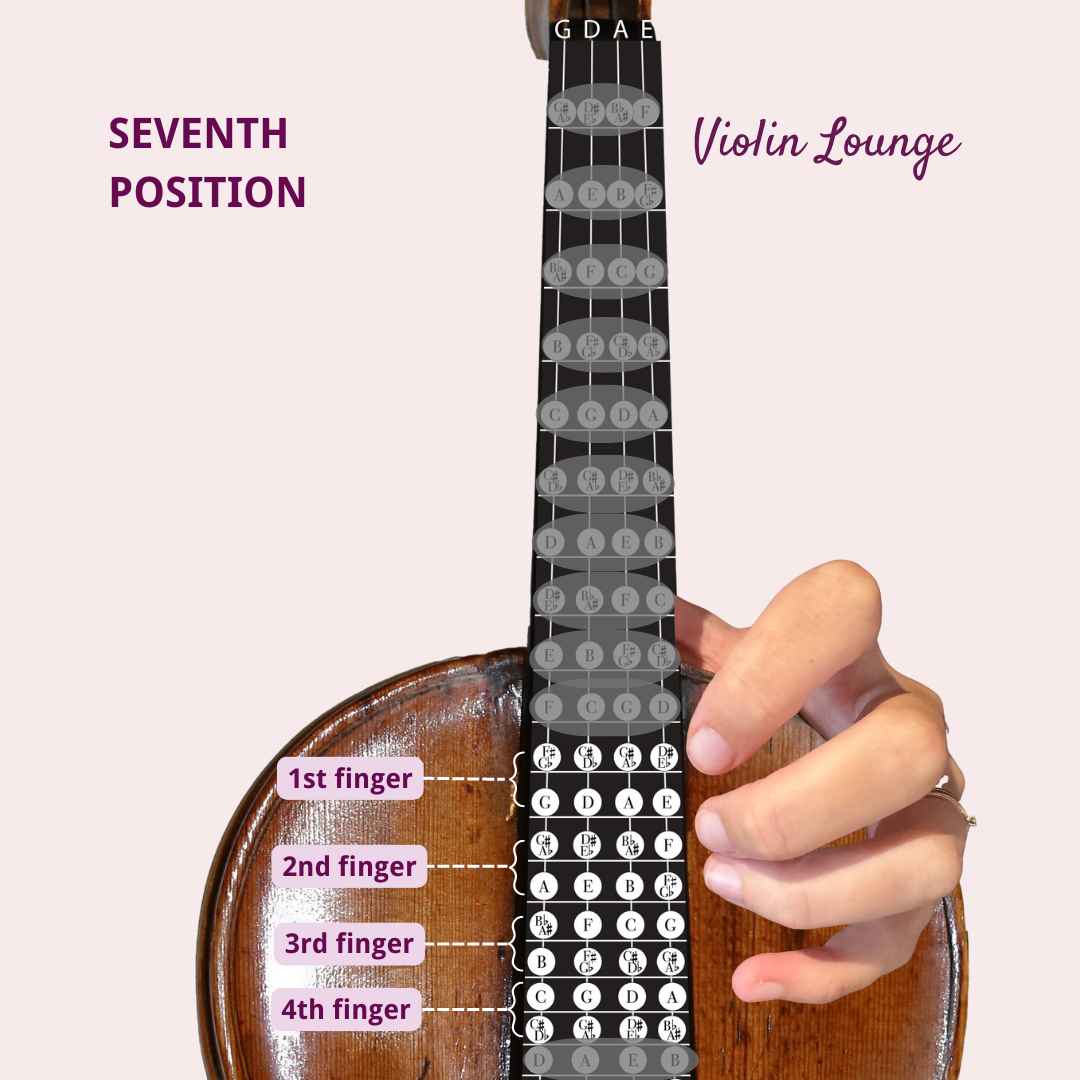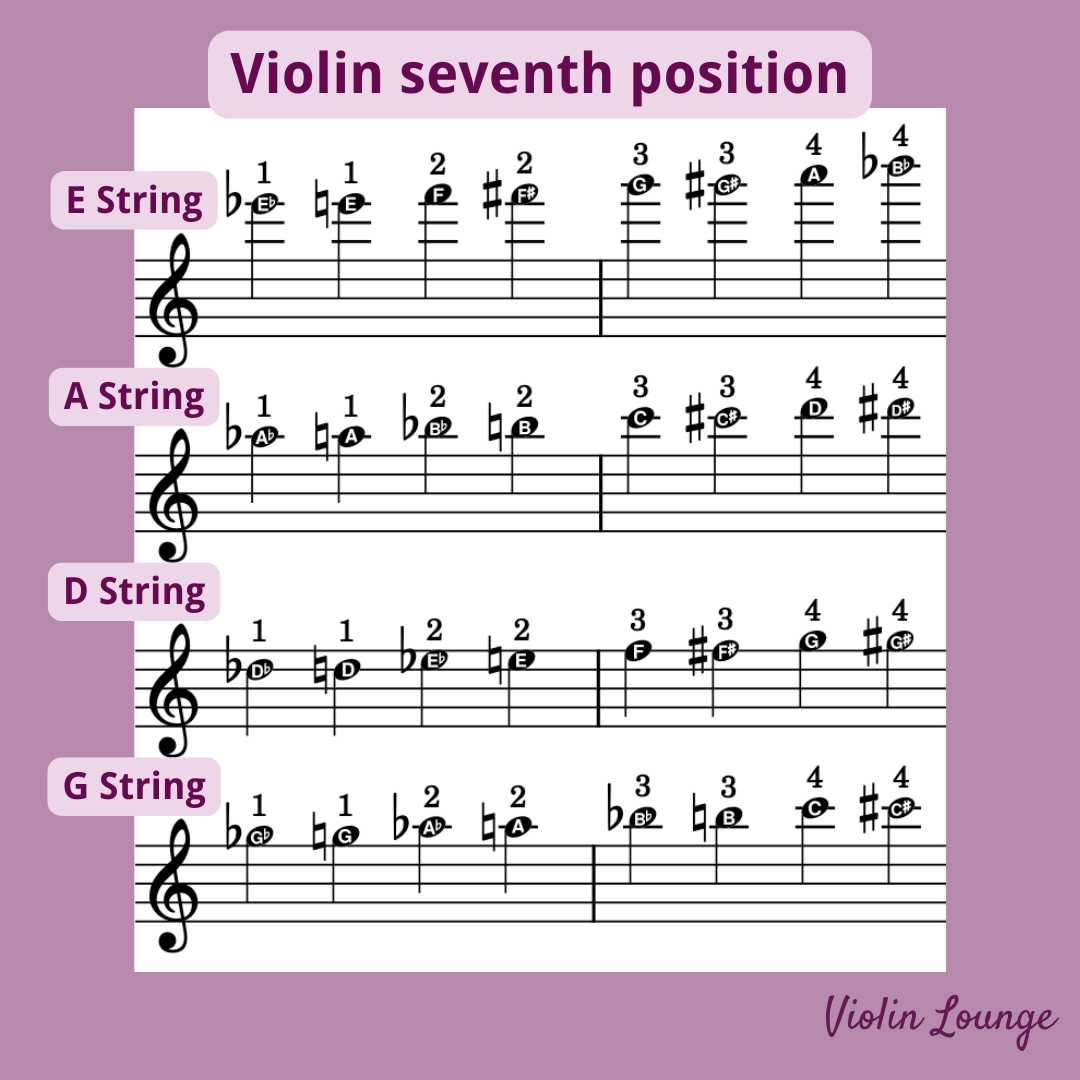Violin Seventh Position – all notes, finger chart and exercises
The seventh position on the violin starts halfway the vibrating string length: on the first octave
If you’ve practed the octave harmonic, the seventh position will be easy to find.
Finding Seventh Position
Seventh is a VERY high position, and can seem intimidating. Want to know a secret? All the techniques in the other positions apply to seventh position too. It’s not it’s own scary thing, just use the shifting methods and exercises you’ve been doing up to this point! Seventh position is one of my favorites, and it can be yours, too.
Many people struggle to find a position that starts so high up. Here’s a few helpful tricks:
- Remember discussing harmonics in my other shifting articles? Seventh position starts on the harmonic that’s an octave above the open string you’re on. If you can hear this harmonic when you touch the string lightly with your first finger, you’re in the right spot!
- In lower positions, the left thumb and first finger move together. Starting from high fifth position (i.s. C# on the E string) first finger starts to inch forward while the thumb stays put against the violin’s heel. By the time you get to seventh, your finger should be about 1 ½ inches ahead of your thumb.
- Seventh position starts on the note that is one octave above the open string you are on. So an E for E string, A for A string, etc.
Finger Chart of Seventh Position
Like other high positions, you can think of seventh as having a “low” and a “high” version, depending what key you are in. For example, E♭ on the E string would be low seventh position: high seventh would be E natural.

Notes in Seventh Position
The full chromatic range of notes you can play in seventh position is as follows:
G string: F#/G♭, G, G#/A♭, A, A#/B♭, B, C, C#/D♭
D string: C#/D♭, D, D#/E♭, E, F, F#/G♭, G, G#/A♭
A string: G#/A♭, A, A#/B♭, B, C, C#/D♭, D, D#/E♭
E string: D#/E♭, E, F, F#/G♭, G, G#/A♭, A, A#/B♭
Sheet music of the seventh position
This is what the seventh position notes look like in violin sheet music. I’ve chosen between notes that are enharmonically the same. Of course if a F# is possible, a Gb is possible too (also see the finger chart above).

Example of Seventh Position
Seventh position comes up constantly in advanced violin repertoire: you will find it sprinkled throughout virtually all the major concertos. As an example, here is the opening from the fifth movement of Lalo’s Symphonie Espagnole. Watch the sheet music video, then the performance. Specifically, pay attention to the trills in mms. 30 and 31. These F# trills on 2nd finger are in seventh position. You can see what this looks like in Hadelich’s playing. Also, notice that the eighth notes in the preceding measure move from third to fifth to seventh. This common pattern avoids sudden leaps.
Start this video at 7:10
Start this video at 26:16
Seventh Position in Sheet Music
Here are some books and pieces that will give you more practice in seventh position:
- Introducing the Positions Vol. 2 by Harvey S. Whistler
- Changes of Position and Preparatory Scale Studies Op. 8 by Sevcik
- Scale System by Carl Flesch
- 42 Etudes by Rudolphe Kreutzer
- Violin Concerto in C Major by Kabalevsky
Note on Seventh Position on Lower Strings
Usually, you will encounter seventh position on the E string. However, composers often love to use high positions on low strings because it creates a special color. The challenge here is getting your hand around the neck of the instrument and staying in tune.
Let’s return to our Augustin Hadelich example from the video above, this time in the fourth movement. Here he is playing in seventh position on the G string (start the video at 23:40). First, notice how far around his left elbow is. This helps him get his hand up around the instrument. Also notice how deep into the string his bow is, and how slowly the bow has to move quickly to vibrate such a short length of string.
Playing in seventh position on the G string doesn’t have to feel awkward. Practice playing scales up and down on one string. When doing big shifts, always shift with a guide finger down. For example, if you need to play a B above middle C on the G string, slide on second finger to A, then put third on B. This creates stability.
My last tip is to play on the ball of your fingers, not the tip. This will cover the string better, providing stronger intonation, vibrato, and comfort.

0 Comments